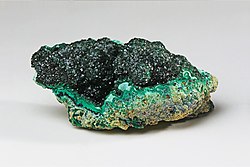Difference between revisions of "Malachite"
(Created page with "{{Other uses}} {{Infobox mineral | name = Malachite | category = Carbonate mineral | boxwidth = | boxbgcolor = | image = Malachite, Zaire.jpg | capt...") |
m (1 revision) |
(No difference)
| |
Latest revision as of 08:57, 20 August 2012
| Malachite | |
|---|---|
 Malachite from the Congo | |
| General | |
| Category | Carbonate mineral |
| Chemical formula | Cu2CO3(OH)2 |
| Strunz classification | 05.BA.10 |
| Identification | |
| Molar mass | 221.1 g/mol |
| Color | Bright green, dark green, blackish green, commonly banded in masses; green to yellowish green in transmitted light |
| Crystal habit | Massive, botryoidal, stalactitic, crystals are acicular to tabular prismatic |
| Crystal system | Monoclinic—prismatic H-M Symbol (2/m) Space group P21/a |
| Twinning | Common as contact or penetration twins on {100} and {201}. Polysynthetic twinning also present. |
| Cleavage | Perfect on {201} fair on {010} |
| Fracture | Subconchoidal to uneven |
| Mohs scale hardness | 3.5–4.0 |
| Luster | Adamantine to vitreous; silky if fibrous; dull to earthy if massive |
| Streak | light green |
| Diaphaneity | Translucent to opaque |
| Specific gravity | 3.6–4 |
| Optical properties | Biaxial (–) |
| Refractive index | nα = 1.655 nβ = 1.875 nγ = 1.909 |
| Birefringence | δ = 0.254 |
| References | <ref name=Handbook>Malachite in Handbook of Mineralogy</ref><ref>Malachite at Webmineral</ref><ref name=Mindat>Malachite at Mindat</ref> |
Malachite is a copper carbonate hydroxide mineral, with the formula Cu2CO3(OH)2. This green-colored mineral crystallizes in the monoclinic crystal system, and most often forms botryoidal, fibrous, or stalagmitic masses, in fractures and spaces, deep underground, where the water table and hydrothermal fluids provide the means for chemical precipitation. Individual crystals are rare but do occur as slender to acicular prisms. Pseudomorphs after more tabular or blocky azurite crystals also occur<ref name=Mindat/>. Typical malachite is laminated and whether or not microbes intervene in its formation is unknown.
Contents
Etymology and history
The stone's name derives (via Latin: molochītis, Middle French: melochite, and Middle English melochites) from Greek Μολοχίτης λίθος molochitis lithos, "mallow-green stone", from μολόχη molōchē, variant of μαλάχη malāchē, "mallow".<ref>Malachite, Dictionary.com</ref> The mineral was given this name due to its resemblance to the leaves of the Mallow plant.<ref>Harper, Douglas. "malachite". Online Etymology Dictionary. http://www.etymonline.com/index.php?term=malachite.</ref>
Malachite was used as a mineral pigment in green paints from antiquity until about 1800. The pigment is moderately lightfast, very sensitive to acids and varying in color. The natural form was being replaced by its synthetic form, verditer amongst other synthetic greens. It is also used for decorative purposes, such as in the Malachite Room in the Hermitage, which features "The Tazza", a large malachite vase and one of the largest pieces of malachite in North America. A gift from Tsar Nicholas II, it stands as the focal point in the center of the room of Linda Hall Library.
Archeological evidence indicates that the mineral has been mined and smelted at Timna valley in Israel for over 3,000 years.<ref>Parr, Peter J review of "Timma: Valley of the Biblical Copper Mines" by Beno Rothenberg Bulletin of the School of Oriental and African Studies, University of London, Vol. 37, No. 1, In Memory of W. H. Whiteley (1974), pp. 223–224</ref>
Occurrence
Malachite often results from weathering of copper ores and is often found together with azurite (Cu3(CO3)2(OH)2), goethite, and calcite. Except for its vibrant green color, the properties of malachite are similar to those of azurite and aggregates of the two minerals occur frequently. Malachite is more common than azurite and is typically associated with copper deposits around limestones, the source of the carbonate.
Large quantities of malachite have been mined in the Urals, Russia. It is found worldwide including in the Democratic Republic of Congo; Gabon; Zambia; Tsumeb, Namibia; Mexico; Broken Hill, New South Wales; Lyon, France; Timna valley, Israel, and in the Southwestern United States notably in Arizona.<ref>Mindat map with over 8500 locations</ref>
Malachite gallery
Slice through a double stalactite, from Kolwezi, Democratic Republic of Congo. Size 5.9 × 3.9 × 0.7 cm.
A polished slab of malachite, from the Democratic Republic of Congo
Ball-and-stick model of malachite's unit cell
Malachite and azurite, from Morenci, Arizona USA. Size 4.4×4.1×2.2 cm.
Malachite stalactites (to 9 cm height), from Kasompi Mine, Katanga Province, Democratic Republic of Congo. Size: 21.6×16.0×11.9 cm.
Botryoidal malachite from Bisbee, Arizona USA. Size 10.5×6.3×5.6 cm.
Neoclassical vase in malachite in the Hermitage Museum, St Petersburg
See also
References
Further reading
| Look up malachite in Wiktionary, the free dictionary. |
| Wikimedia Commons has media related to: Malachite |
- Hurlbut, Cornelius S.; Klein, Cornelis, 1985, Manual of Mineralogy, 20th ed., John Wiley and Sons, New York ISBN 0-471-80580-7.
- Virtual tour of the Malachite Room
az:Malaxit be:Малахіт bg:Малахит bs:Malahit br:Malakit ca:Malaquita cs:Malachit da:Malakit de:Malachit et:Malahhiit el:Μαλαχίτης es:Malaquita eo:Malakito eu:Malakita fa:مالاکیت fr:Malachite gl:Malaquita ko:공작석 hi:ताप्रांगीयिज hr:Malahit io:Malakito is:Malakít it:Malachite he:מלכיט ka:მალაქიტი kk:Малахит la:Malachites lt:Malachitas hu:Malachit ms:Malakit nl:Malachiet ja:孔雀石 pl:Malachit pt:Malaquita ro:Malachit ru:Малахит sk:Malachit sl:Malahit sh:Malahit fi:Malakiitti sv:Malakit th:มาลาไคต์ tr:Malahit uk:Малахіт ug:يېشىل تاش vi:Malachit zh-yue:石綠 zh:碱式碳酸铜






